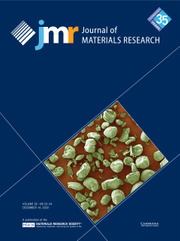Article contents
Inner surface reaction and modification of titanium alloy by a new plasma source ion implantation method
Published online by Cambridge University Press: 31 January 2011
Extract
The inner surface of a cylindrical titanium alloy target was successfully implanted with nitrogen ion using a new plasma source ion implantation method. By means of x-ray photoelectron spectroscopy and x-ray diffraction, the reactive phases and their chemical state in the implanted layer were investigated. In order to characterize the modification effect and its uniformity, the retained dose and the microhardness at seven different positions along the axis on the inner surface of the cylindrical target were measured, respectively. The experimental results show that a TiN reactive phase was formed in the implanted layer, which contributed to the improvement of inner surface microhardness. The root-mean-square deviations of retained dose and microhardness measured along the axis of the target are less than 9% and 4%, respectively, which are well within an acceptable tolerance range for metallic applications of ion implantation.
Information
- Type
- Articles
- Information
- Copyright
- Copyright © Materials Research Society 1998
References
- 2
- Cited by

